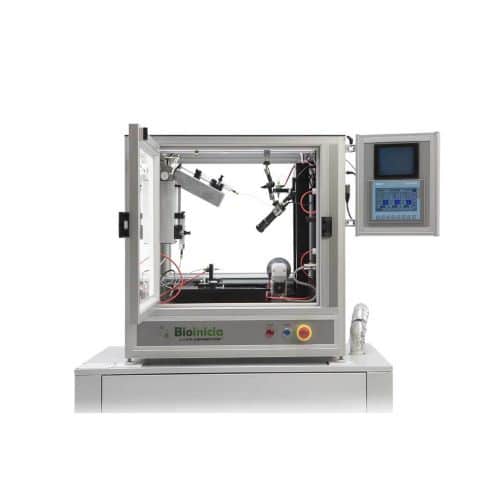Electrospinning is a technique for manufacturing fibres by coaxially stretching a viscous and elastic solution. These fibres have minimal diameters and are therefore known as nano and microfibers. This consequence is achieved because the polymer used as a material is subjected to techniques that make use of electromagnetic principles, such as electrostatics. The results are polymer generating fibres of various sizes, but always remaining very thin.
Among the characteristics of these micro and nanofibres are their high elasticity and resistance. The cause is that the material used is resistant and that the surface of the fibre is very porous, which makes it very easy to bend. They also have an extensive surface area about the volume of the fibre itself. All these features make these fibres ideal for multiple uses, so electrospinning biomedical applications are varied, as well as in the related textile and pharmaceutical industries in the sector.
How electrospinning machines work
This is how the devices manufacture fibres electrospinning are mounted: an infusion pump pumps the solution of the polymer through a needle or a cone arranged horizontally, when it reaches almost the end, it receives electromagnetic energy from a high voltage source, and the solution is expelled in the form of a fibre. Next to it, there is a collecting plate in a vertical orientation, which will receive electromagnetic energy of the same intensity and source as the needle. Here the fibres are received after the solvent has evaporated.
The same process can be done by placing the needle vertically and the collector plate horizontally underneath. This arrangement is not recommended, because drops of the solution may fall and interrupt the process, due to the high viscosity of the solution.
In some machines, the arrangement and final thickness of the fibres will be chosen at random. However, the most advanced machinery allows controlling the thickness, diameter, pores and alignment. In this way, the most suitable fibre can be created for each use. The wide variety of materials allows the fibres created by electrospinning to satisfy many needs. The characteristics of the fibre material to be used are taken into account: mechanical properties, surface chemistry, elasticity, absorption capacity, bioactivity, etc.
Its usefulness in medicine
In the pharmaceutical industry, capsules can be made from fibres created through the use of electrospinning. The result is that the body absorbs the medication much more efficiently, without the need to consume any non-biodegradable agents. There is also the advance that allows the gradual release of drugs, which can be given, thanks to the response of external stimulus (such as a change in the person’s pH or temperature, for example).
Electrospinning has great advantages at the pharmaceutical level. The variety in the polymers that can be used for the creation of fibers is such that a more precise control of the supply of the drug can be achieved. This method presents a great advance for the treatment of diseases such as cancer, which require the focusing of the compound in a specific area to decrease the side effects of the treatment.
Technological advances in this area are aimed at making the release of the drug and its absorption by the body more efficient and effective. The result is that there are considerable improvements in the effectiveness of the application of medication.
About textiles related to medicine, fabrics dedicated to wound care can be developed. This production is because the fibres have a high degree of porosity, flexibility and the pores are small. The dressing that is manufactured protects the wound against possible bacterial infections, while allowing for the necessary exchange of gases and liquids.
Tissues can also be manufactured that allow for the application of antibiotics and wound healing without adverse effects. Fibres can carry bioactive ingredients without altering them.
Other medical uses for fibres created with electrospinning are: bone and tooth replacement, grafts, artificial blood vessels, etc. It works very well in the implantation of factors external to the body, thanks to the variety of materials that can be used to create them.
Electrospinning has a high range of applications in biomedicine. More and more products are created with the fibres resulting from this process. It is proving to be an essential advance in the treatment of injuries and diseases, and the trend is for its increasing applicability in the medical and pharmaceutical sector.
The use of electrospinning has become popular over the years because of its considerable advantages. The number and variety of uses that can be given to microfibers are impressive, so it is normal that there are more and more industries that apply this technology. The use of electrospinning has become popular over the years because its advantages are considerable. The amount and variety of uses that can be given to microfibers are impressive, so it is normal that more and more industries are applying this technology. The production costs are meagre, compared to other methods that are less effective. It is a very attractive option for many sectors.




